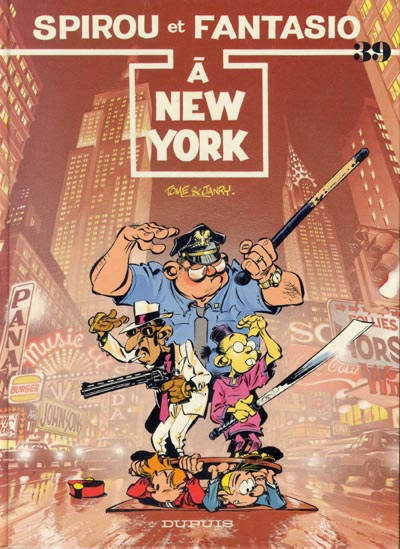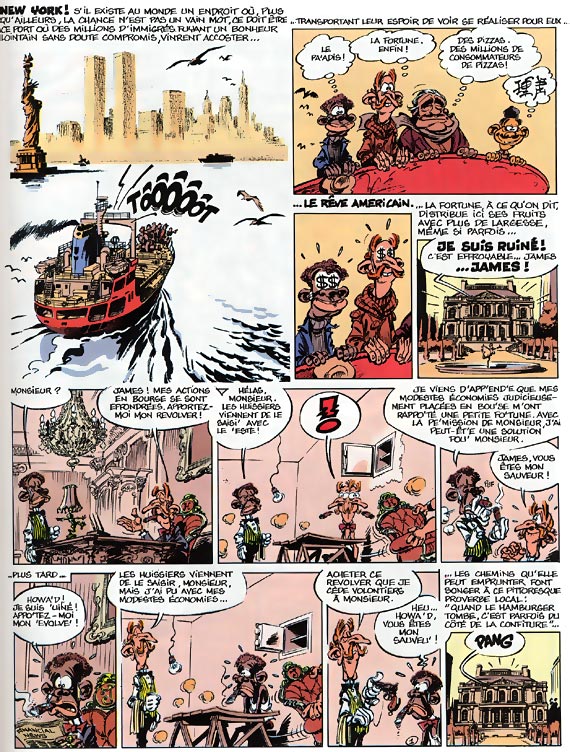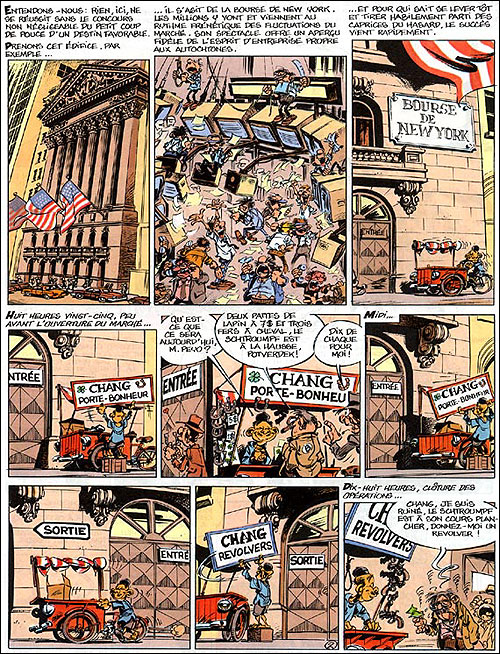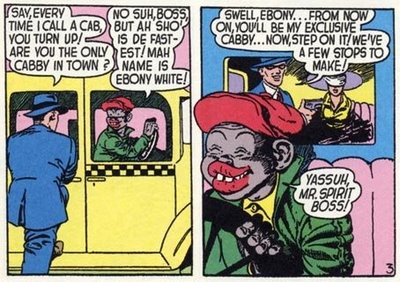The above cover pretty much says it all.
The heroes of this comic, Spirou and Fantasio, in hiding while two jarringly offensive racist stereotypes and a corrupt cop look for them…but let’s back up a little.
Spirou was created in 1938 by the cartoonist Robert Welter (1909-1991), who signed his work Rob-Vel. Contrary to common practice in Belgian and French comics, he sold all rights to the strip to his publisher, Dupuis, in the late forties. As a result, from then to now it has been produced by different successive cartoonists, working either solo or in teams.
The team of writer Philippe Vandevelde – a.k.a. Tome — and artist Jean-Richard Guerts — Janry — had a run on the strip from 1982 to 1998. Commercially, it was Spirou’s most successful period: each album sold over 150 000 copies in its first year, and joined a steady-selling backlist of fifty titles. Though little-known in anglophone countries, as compared to his arch-rival Tintin, Spirou is one of the most successful comics franchises in European history, with sales in the hundreds of millions in over 30 languages.
Tome and Janry’s success is owed to the genuinely disciplined mastery of slapstick comedy, satire, and adventure combined with imaginative use of science-fiction and fantasy, all illustrated in a style that marries meticulous attention to detail with a wild fluidity of caricatured movement.
And yet something in this most accomplished comic strip stinks, something it shares with far too wide a selection of European comics for children.
That something is racism.
***************************************************************
For most of the history of public education in France and Belgium, kids went to school six days a week, with a half day on Thursday and Saturday. With parents at work on Thursday, there grew a whole industry of keeping the bored little sprouts entertained — and the kings of this industry were the weekly comics magazines.
When I was a kid in the sixties, the prize magazines were Le Journal de Tintin, Pilote, Le Journal de Mickey and Le Journal de Spirou. I was fortunate with the last, as this period in Spirou’s history was overseen by Andre Franquin (1924–1997), one of the greatest cartoonists of all time. Franquin gave up the title in 1968, when I turned 14 and dropped kids’ comics in favor of more adolescent fare. (It was the year I discovered Crumb.)
So when I checked in on the much later album I’m writing about here, I was shocked and outraged — but more than I should’ve been, as I’ll explain later on.
Let’s go to page one, where a shipful of immigrants arrive in New York:
Click on page to enlarge
Panel 2 sets the tone for the whole book.
In it, from left to right:
–a blubber-lipped African: “Pa’adise!” (French blackface “humor” mocks Black African accents by leaving out all “r”s.)
— an Englishman: “Fortune, at last!”
— an Italian, modelled on Marlon Brando as the Godfather: “Pizzas. Millions of consumers of pizzas!”
— a Chinese, yellow-skinned and buck-toothed, thinking literally inscrutable calligraphy.
(NB: all translations mine).
The rest of the page is a fairly acid satiric sketch in which the Englishman, having made a fortune, is so wiped out by bankruptcy that he no longer even has a gun to kill himself with. But the African — now his butler — informs him that:
“I’ve just lea’nt that my modest savings judiciously invested in the stock ma’ket have b’ought me a small fo’tune. With Sir’s pe’mission I have pe’haps a solution fo’ Sir.”
Next panel, of course, it’s the African who’s lost his vast fortune and his butler, the Englishman, who supplies his master with a gun. The last panel ends the scene with the African’s tastefully off-stage suicide.
And what of the Chinese? How does he make his fortune? See page 2:
In the morning, he sells good-luck charms to investors outside the Stock Exchange. In the afternoon, he sells them pisols to blow their own brains out . Those cunning, ruthless, wily Orientals.
Chinatown: on the left, all the shops sell good-luck charms. On the right, they all sell guns.
This is the global view of American life presented here. A Darwinian hellhole crammed with unsavory ethnics all out to do each other in. It’s pretty much the standard European far-right’s line for the last century.
The plot is basically a gang war between the cliched, spaghetti-slurping Mafia (who are shown as controlling all of Little Italy) and the vicious Chinese, who have the upper hand thanks to their supernatural power to curse anyone who gets in their way. Into this war stumble our two lovable Belgian heroes, Spirou and Fantasio, the only characters of sense and integrity — noble Caucasians thrust into the nightmare of an insidious, omnipresent Yellow Peril.
They completely control the police, for example. When warned of this by a taxi driver, Fantasio storms off:
“WHAT? We’ll see about that!…Policeman! I want to register a complaint, I’ve been attacked by a dog-pack of bandits…Asiatics…with yellow complexion…”
To his horror, he sees that the cop is himself Chinese. Later, we see the policeman phoning in the encounter to the Chinese gang.
Every ugly sinophobic, Orientalist stereotype is trotted out; Mandarins with four-inch fingernails wearing dragon masks, trick Buddha statues, Fu Manchu moustaches, a disgusting willingness to eat scorpions, cobras and tarantulas, barefoot coolies, pigtails, submissive cheongsam-clad lovelies…enough! My stomach can’t take any more.
The total effect is made worse by the high skill of the execution. Such was the case for such racist vileness as the films Birth of a Nation or the Nazi-era The Jew Suss. On its own minor level, Spirou et Fantasio a New York joins this unsavory company.
But in a way that’s more subtly evil.
It’s entertainment pitched at children.
***************************************************************
I’ve written before about the problem of racism in the comics, more particularly regarding Tintin, but acknowledging such problematic (a euphemism for “racist”) strips as The Spirit, Terry and the Pirates, Little Nemo, and Asterix.
All lovers of classic comics (and indeed of classic novels our films, for that matter) have to deal with this poison legacy. Generally we fall back on some pretty flimsy excuses:
— “It’s not really that bad”.
For example, The Spirit‘s Ebony White:
… may be a racist Blackface caricature, but he’s also shown as being brave and lovable.
Patronising. And it applies to none of the race stereotypes in the album under question: apart from the odd Black bystander, all the ethnics in SPEFANY are cowardly, treacherous and greedy, with no redeeming features.
— “It’s actually an ironic use, a parody of racism rather than racism per se.”
Irony is the vehicle for much weaseling; in comics, it’s evoked for the racism in strips such as Robert Crumb’s Angelfood McSpade or Morris and Goscinny’s Lucky Luke. That sort of “irony” strikes me as just a way to have your racist cake and eat it, too.
SPEFANY makes no pretense to irony, anyway. It’s crudely upfront in its racism.
—“You have to see the strip in the context of its time, the ’30s and ’40’s had different attitudes.”
First of all, plenty of people knew back then that bigotry is wrong, so it’s a weak excuse. But let’s grant it for the sake of argument.
Let’s turn to the copyright page of Spirou et Fantasio a New York to see what time period we need to ‘contextualise’ it in.
1987.
Nineteen eighty-seven.
Yes. As recently as 1987, this stew of racist bigotry was deemed perfectly fine to pitch at young children.
And it continues to this day.
Where in America, by the 1950s, blatant racism and other bigotry was being phased out of popular culture… and in Europe for the most part as well… children’s comics were given a free pass to perpetuate the ugliest ethnic and racial stereotypes. They still have this free pass.
I look back, now, at the Spirous and Tintins of my childhood and wince. Who knows how this ethnic propaganda may have warped me subconsciously? Or warped generations of European kids on either side of mine?
So, the above diatribe is not just my venting anger at an evil little book.
I’m angry at myself, too.
__________
Click here for the Anniversary Index of Hate.





